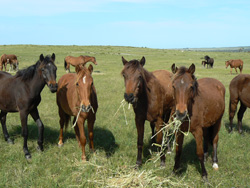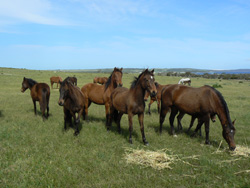1932 - Morgan family bought the Coffin Bay Run. For a period of time during the depression, the pony once again enjoyed a return to popularity. As petrol became unaffordable and unobtainable, the ponies became invaluable as machinery sat rusting in paddocks, unusable. Excess stock at times were taken to Port Augusta for sales.
After peace was declared in 1945, the demand again dropped, as more workers returned to the area and the ponies were no longer needed in such numbers. Moss Morgan, for many years, made a modest living, partly assisted by the catching and breaking of wild ponies for sale to locals as riding ponies. Many locals can still remember local Coffin Bay ponies as buck jumpers at the local rodeos. |
| 1927 - Coffin Bay Run was sold to Martin Cash. Towards to end of the Mortlock era, maintenance of the Run had become erratic and progress had taken its toll on the financial success of breeding horses. At this stage in their history, the ponies became wild and unmanagable to a large degree, becoming large in number and a problem for the new owner. This led to culling and mass destruction to reduce numbers. |
| 1857-58 - Coffin Bay Run was sold to W.R.Mortlock, who saw the potential of this hardy little pony and brought in selected stallions to expand their versatility by adding height and enhancing natural characteristics. Stallions brought in are said to have been Welsh Cob, Thoroughbred and Arabian. This selective breeding resulted in much sought after specialty larger size ponies and horses, with buyers coming from interstate and overseas to purchase 4 in hand, matched pairs, polo ponies and Army remounts. |
|
 |






